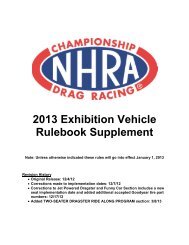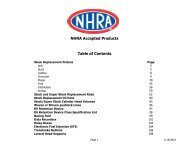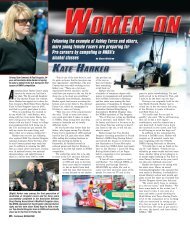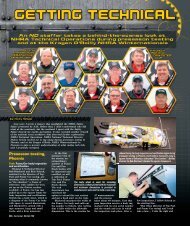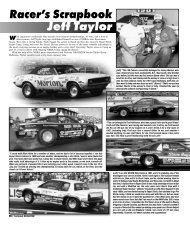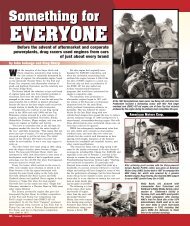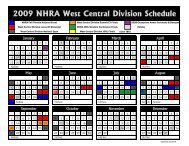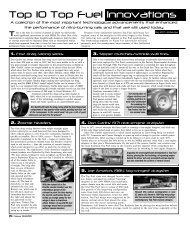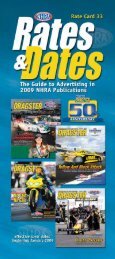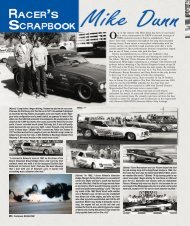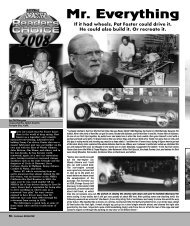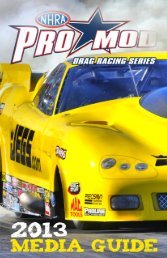Gas Ronda.pdf - NHRA.com
Gas Ronda.pdf - NHRA.com
Gas Ronda.pdf - NHRA.com
Create successful ePaper yourself
Turn your PDF publications into a flip-book with our unique Google optimized e-Paper software.
The dapper former dance instructor put Ford on the racing map during<br />
the days of heads-up Super Stock racing and the early Funny Cars<br />
by John Jodauga<br />
During the 1970s and 1980s, Bob<br />
Glidden was the favorite of Ford<br />
drag racing fans with his near-total<br />
domination of Pro Stock, and John<br />
Force has shined in a similar role in<br />
Funny Car in the last two decades, but<br />
throughout the 1960s, the man who<br />
gave Ford fans the most reasons to<br />
cheer was <strong>Gas</strong> <strong>Ronda</strong>, the Super Stock<br />
standout who went on to play a major<br />
pioneering role in the early days of<br />
Funny Car racing.<br />
<strong>Ronda</strong> won the <strong>NHRA</strong> Top Stock<br />
championship in 1964, the year the<br />
class was introduced, and that played a<br />
major role in Ford winning <strong>NHRA</strong>’s<br />
first Manufacturers Cup. Later in the<br />
decade, he emerged as one of the<br />
strongest West Coast Funny Car<br />
campaigners. But in 1970, the same<br />
year the Pro Stock class was introduced,<br />
Rhonda’s driving career was<br />
ended prematurely after he suffered<br />
major burns from an engine fire. Many<br />
drag racing observers felt that <strong>Ronda</strong>’s<br />
skills with the four-speed transmission<br />
would have made him a superstar in<br />
Pro Stock.<br />
Another aspect that made <strong>Ronda</strong><br />
stand out from other racers was being<br />
one of the sharpest-dressed racers of<br />
his era. Much of that came from his<br />
days as a dance instructor when he<br />
lived in the San Francisco area in the<br />
1950s. After he began to rise up in the<br />
drag racing ranks, <strong>Ronda</strong> continued to<br />
wear more stylish clothing than the T-<br />
shirts and Levi’s that were <strong>com</strong>mon<br />
during the era, and he insisted that<br />
his crewmembers do the same.<br />
His drag racing career began in the<br />
early 1950s as a outlet to relieve<br />
him of the many hours spent in his<br />
dance classes. He initially campaigned<br />
a Hudson Hornet because he wanted<br />
to race something different and had<br />
also heard about how successful<br />
Marshall Teague was with that type of<br />
vehicle in stock car racing.<br />
In 1953, Rhonda opened a dance<br />
school franchise in Hayward, Calif.,<br />
next to a Buick dealership that was<br />
owned by former Indy winner Bob<br />
Sweikert and Chet Richards. They<br />
eventually coaxed <strong>Ronda</strong> into switching<br />
to a new Buick Century in 1954. By<br />
the late 1950s, <strong>Ronda</strong> was running a<br />
Chevrolet Corvette, but, he said, “I<br />
didn’t like the fact that everyone had a<br />
Chevrolet. To me, there was no sense<br />
of ac<strong>com</strong>plishment in beating one<br />
Chevy with another Chevy.”<br />
So, in 1960, <strong>Ronda</strong> began racing his<br />
first Ford, equipped with the then-new<br />
352-cid, 360-horsepower V-8. It was with<br />
this car that <strong>Ronda</strong> began his longtime<br />
association with Les Ritchey, who ran<br />
the highly successful Performance<br />
Associates shop in Covina, Calif. By<br />
late 1962, Ritchey had talked <strong>Ronda</strong>,<br />
who was now out of dance instruction<br />
<strong>com</strong>pletely, into<br />
moving to Southern<br />
California, where he<br />
first campaigned<br />
for sponsor<br />
Downtown Ford in<br />
Los Angeles.<br />
Though Fords<br />
were underdogs to<br />
the more powerful<br />
Chevy 409s that<br />
were driven by<br />
most of the other Super Stock racers,<br />
such as Don Nicholson, Hayden<br />
Proffitt, Dave Strickler, the Sox &<br />
Martin team, Butch Leal, and others,<br />
<strong>Ronda</strong> proved to be very <strong>com</strong>petitive<br />
once he started running engines that<br />
were built and tuned by Ritchey.<br />
<strong>Ronda</strong>’s loyalty to the Ford brand<br />
paid off in 1964 when he was given an<br />
original factory Ford Thunderbolt, one<br />
of the potent midsize Fairlanes that<br />
were powered by the 427-cid, high-riser<br />
wedge engines.<br />
During the middle of that season,<br />
<strong>Ronda</strong> left Downtown Ford to begin<br />
working out of the Russ Davis Ford dealership<br />
in Covina, where he could be<br />
closer to Ritchey’s shop. When he wasn’t<br />
racing, <strong>Ronda</strong> was a salesman on the<br />
dealership floor, and he sold many Ford<br />
Mustangs and Fairlanes with the potent<br />
289-cid, 271-horsepower Cobra Jet engine<br />
and offered his customers price-saving<br />
deals on having their engines<br />
blueprinted by Ritchey.<br />
Said <strong>Ronda</strong>, “During my first year<br />
at Russ Davis’ dealership, the sales for<br />
high-performance parts went up by<br />
over 1,000 percent.”<br />
<strong>Ronda</strong> became so synonymous with<br />
the Ford factory racing program that<br />
he resisted the temptation to convert<br />
his <strong>NHRA</strong>-legal A/FE Ford Mustang<br />
into a Funny Car during 1965, when<br />
the switch to the “run whatcha brung”<br />
entries was in full swing. In 1966,<br />
Ford provided <strong>Ronda</strong> with a truly<br />
<strong>com</strong>petitive Funny Car, and his<br />
stretched-wheelbase Mustang was one<br />
of the first of its breed to run eightsecond<br />
times on a regular basis.<br />
But tragedy struck early in 1966,<br />
when Ritchey was involved in a fatal<br />
accident while racing in Fontana, Calif.<br />
Said <strong>Ronda</strong>, “Not only did I lose my<br />
engine builder but also my best friend.<br />
It took me a long time to get over<br />
that. When I began racing after that, I<br />
to page 38<br />
One of the early Fords that <strong>Gas</strong> <strong>Ronda</strong> campaigned was a 406-cid, 405-<br />
horsepower ’62 Galaxie. The Ford racing program was still relatively new at<br />
the time, and <strong>Ronda</strong> was one of the few Ford racers who was able to keep<br />
up with the favored 409-cid Chevrolets that were campaigned by the likes<br />
of Hayden Proffitt, far lane.<br />
36 ✦ National DRAGSTER
● <strong>Gas</strong> Rhonda<br />
from page 36<br />
did so very conservatively and tuned<br />
the car to just run in the nines for<br />
quite some time.”<br />
But by 1967, <strong>Ronda</strong> had regained his<br />
bravado and ran a new Mustang with a<br />
tilt front end that originally ran with<br />
fuel injection but later was equipped<br />
with a supercharger that gave him sevensecond<br />
elapsed time potential.<br />
For 1969, <strong>Ronda</strong> had a new Mach 1<br />
Mustang built by Logghe Bros.<br />
that was easily the fastest and bestlooking<br />
ride of his<br />
career, but after scoring<br />
his prestigious win at<br />
that year’s Orange<br />
County Int’l Raceway<br />
Manufacturers<br />
Championships, <strong>Ronda</strong><br />
suffered severe burns in<br />
his early 1970 accident<br />
while racing in Phoenix,<br />
and his driving career<br />
was brought to an abrupt<br />
halt. Said <strong>Ronda</strong>, “Ford<br />
tried to get me to run in<br />
Pro Stock later that year,<br />
but with my left leg<br />
burned so badly, I<br />
couldn’t operate the<br />
clutch properly.”<br />
<strong>Ronda</strong> then went into<br />
the nightclub business,<br />
where he enjoyed great success. He<br />
retired in 1993.<br />
Still very active at age 82, <strong>Ronda</strong><br />
lives with his wife in Palm Desert,<br />
Calif., where he plays golf regularly<br />
and enjoys driving his 2005 Mustang<br />
GT, which has been performance<br />
enhanced by Randy Ritchey, who has<br />
resurrected the Performance<br />
Associates business founded by his<br />
father, Les.<br />
Said <strong>Ronda</strong>, “Looking back on my<br />
career, I wouldn’t change a thing. Even<br />
though I suffered a setback with the<br />
engine fire, I knew the risks that were<br />
involved when I got into racing, and<br />
the good far outweighs the bad. We<br />
even learned from our losses, and<br />
that helped us win more races,<br />
which, of course, was something<br />
that I always enjoyed.” ND<br />
Greg Sharp collection<br />
(Above) <strong>Ronda</strong>’s 1963 ride was this 12-second Ford Galaxie<br />
fastback. Despite the addition of fiberglass fenders,<br />
lightweight bucket seats, aluminum vendors, and other<br />
weight-saving devices, it still was heavier than other<br />
brands, especially the midsize Dodge and Plymouth entries,<br />
a handicap that was challenging to over<strong>com</strong>e. (Left) Ford<br />
finally put together a very <strong>com</strong>petitive racing package in<br />
1964 with the famed Ford Thunderbolts that <strong>com</strong>bined the<br />
power of the 427-cid, 425-horsepower high-riser wedge<br />
with the lightweight Ford Fairlane body. Note the “four-leaf<br />
clover” style bulge in the hood for the cold-air induction<br />
system that was later seen in the more popular teardrop<br />
design. (Below) After scoring SS/S class honors at the<br />
season-opening Winternationals, <strong>Ronda</strong> made a midseason<br />
switch to Russ Davis Ford in Covina, Calif., where he could<br />
be closer to his engine builder and tuner Les Ritchey. <strong>Ronda</strong><br />
had his car repainted in the popular Mustang poppy red and<br />
went on to win the inaugural Hot Rod Magazine<br />
Championships in Riverside, Calif.,<br />
and the <strong>NHRA</strong> Top Stock<br />
points championship.<br />
(Left) <strong>Ronda</strong> really enjoyed driving this four-speedequipped,<br />
10-second A/FX Ford Mustang that was<br />
powered with Ford’s new high-winding 427-cid SOHC<br />
Hemi engine. Although many of his fellow <strong>com</strong>petitors<br />
jumped to “outlaw” altered-wheelbase, nitro-burning<br />
Funny Cars to run on the lucrative match race circuit<br />
that year, <strong>Ronda</strong> <strong>com</strong>plied with Ford’s wishes for him<br />
to stick with the <strong>NHRA</strong>-legal program for the balance<br />
of the season.<br />
38 ✦ National DRAGSTER<br />
(Left) In an ironic twist that <strong>Ronda</strong> and the Ford officials<br />
thoroughly enjoyed, <strong>Ronda</strong> won this Plymouth Barracuda<br />
from Hurst Performance with his triumph at the Hot Rod<br />
Magazine Championships. <strong>Ronda</strong> had the car on display<br />
at the Ford dealership, and he won another Barracuda<br />
when he clinched the <strong>NHRA</strong> Top Stock title. (Right)<br />
Ritchey, a longtime Ford campaigner and owner of<br />
Performance Associates, played a major role in <strong>Ronda</strong>’s<br />
success as <strong>Ronda</strong>’s engine builder, tuner, business<br />
advisor, and close friend.
(Left) Ford provided <strong>Ronda</strong> with his first Funny Car in 1966, a stretched-wheelbase, injected<br />
entry that recorded then-record eight-second clockings to win the Bakersfield, Calif., March<br />
Meet. (Below) Now 82 years old, <strong>Ronda</strong> still has his zest for high performance. His daily ride<br />
is an ’05 Mustang, which has been tuned and modified<br />
for extra power by Randy Ritchey, son of <strong>Ronda</strong>’s<br />
longtime engine builder and best friend, Les.<br />
<strong>Ronda</strong> stepped up with an even<br />
more potent entry in 1967 with this<br />
Mustang that was originally<br />
campaigned with fuel injection but<br />
was upgraded with a supercharger<br />
later in the season. Following<br />
Ritchey’s fatal accident in 1966,<br />
<strong>Ronda</strong> now relied on the enginebuilding<br />
services of Ed Pink.<br />
At the 1968 Winternationals, <strong>Ronda</strong> took a trip back in<br />
time by returning to his original four-speed roots to help<br />
Ford debut its Cobra Jet SS/EA Mustangs.<br />
<strong>Ronda</strong>’s Funny Car career hit its peak in 1969,<br />
when he began driving this sharp-looking ’69<br />
Mustang that featured a state-of-the-art Logghe<br />
Bros. chassis. His biggest victory came at the<br />
1969 Orange County Int’l Raceway<br />
Manufacturers Cup Funny Car Championships,<br />
where he defeated the heavily favored Chi-Town<br />
Hustler of Farkonas Coil & Minnick in the final.<br />
At the recent <strong>NHRA</strong> California Hot Rod Reunion, <strong>Ronda</strong> was the<br />
subject of the Justice Bros. Spotlight Award. <strong>Ronda</strong> signed<br />
autographs throughout the weekend for fans, who also got a chance<br />
to check out his supercharged ’68 Mustang Funny Car that was<br />
restored by vintage car collector Brent Hjak.<br />
November 14, 2008 ✦ 39



